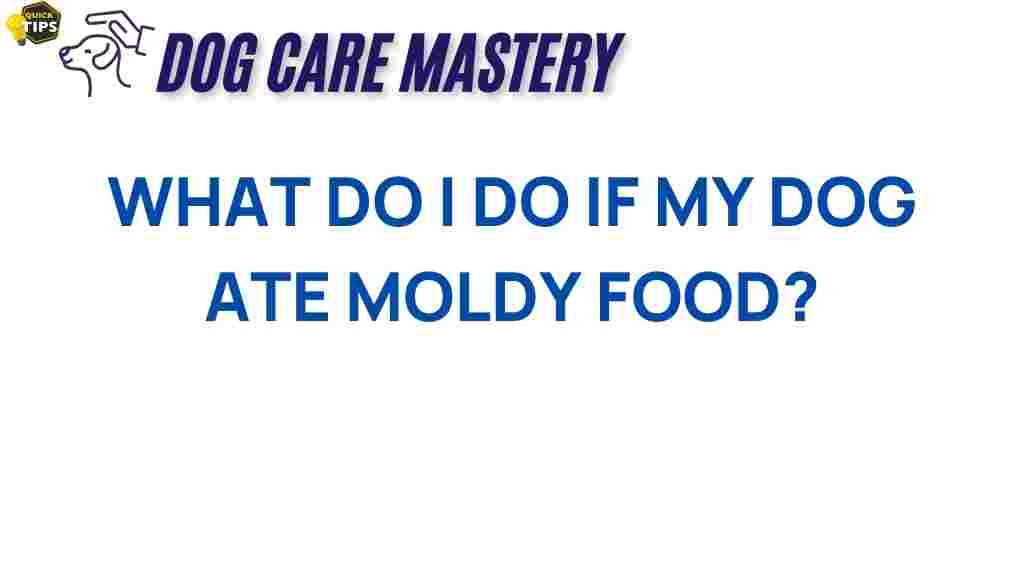What to Do When Your Dog Eats Moldy Food: A Vet’s Insight on Dog Health
As a dog owner, it’s crucial to prioritize your pet’s dog health at all times. One of the unexpected challenges that may arise is your furry friend consuming moldy food. Whether it’s a forgotten piece of bread or leftovers left unattended, moldy food can pose serious health risks to dogs. In this article, we will delve into the potential dangers of moldy food, what you should do if your dog ingests it, and how to maintain your pet’s health in the long run.
Understanding the Risks of Moldy Food
Before we discuss the steps to take if your dog eats moldy food, it’s essential to understand why moldy food is harmful. Moldy food may contain:
- Mycotoxins: These are toxic compounds produced by mold that can lead to severe health issues.
- Fungal Infections: Some molds can cause infections, especially in dogs with weakened immune systems.
- Gastrointestinal Distress: Ingesting moldy food can lead to vomiting, diarrhea, and abdominal pain.
Being informed about the risks will help you respond effectively if your dog consumes moldy food.
Immediate Steps to Take
If you discover your dog has eaten moldy food, follow these steps to ensure their dog health is not compromised:
- Stay Calm: Your reaction can influence your dog’s behavior. Staying calm can help you assess the situation more effectively.
- Check for Symptoms: Monitor your dog closely for any signs of distress, such as:
- Vomiting
- Diarrhea
- Excessive drooling
- Lethargy
- Loss of appetite
- Contact Your Veterinarian: If your dog exhibits any symptoms, call your vet immediately. Provide details about the type of food consumed and the time of ingestion.
- Do Not Induce Vomiting Without Guidance: Inducing vomiting can sometimes do more harm than good. Always consult your veterinarian before taking this step.
What Happens Next?
Once you contact your vet, they will likely ask for specific details to assess the situation better. Be prepared with the following information:
- The type of food your dog ate
- The amount ingested
- The time of ingestion
- Any symptoms your dog is currently experiencing
Your vet may recommend bringing your dog in for an examination or may provide instructions for home care, depending on the severity of the situation. Always follow their advice closely.
Troubleshooting Tips for Dog Owners
After the immediate concerns are addressed, it’s essential to focus on preventing future incidents. Here are some troubleshooting tips to help maintain your dog’s health:
- Regularly Check Food Supplies: Make it a habit to inspect your dog’s food for mold or spoilage before feeding.
- Store Food Properly: Keep dog food in airtight containers and store it in a cool, dry place.
- Educate Family Members: Make sure everyone in your household understands the importance of keeping moldy food away from your dog.
- Provide a Balanced Diet: Ensure your dog is eating a balanced diet to maintain overall health, which can help mitigate the effects of any accidental ingestion.
Long-Term Dog Health Maintenance
Maintaining your dog’s dog health is an ongoing process. Here are additional steps to ensure your pet stays healthy and happy:
- Regular Vet Check-Ups: Schedule annual wellness exams for your dog to monitor their health and catch any issues early.
- Vaccinations: Keep your dog’s vaccinations up to date to protect against diseases that could complicate health issues.
- Exercise and Mental Stimulation: Regular exercise helps keep your dog physically fit, while mental challenges can prevent boredom-related behaviors.
- Healthy Treats: Opt for natural and healthy treats instead of human leftovers that may spoil quickly.
- Hydration: Ensure your dog has access to fresh water at all times.
Conclusion
Handling the situation when your dog eats moldy food can be stressful, but knowing what steps to take can help minimize risks to their dog health. By understanding the dangers, taking immediate action, and implementing preventive measures, you can protect your canine companion from potential harm. Always consult with your veterinarian for personalized advice and care. For more information on keeping your pet healthy, visit this informative resource.
In case of any doubts or concerns, feel free to reach out to pet health forums or communities where you can share experiences and gain additional insights. Remember, your dog’s health is in your hands!
This article is in the category Safety and created by dogcaremastery Team
